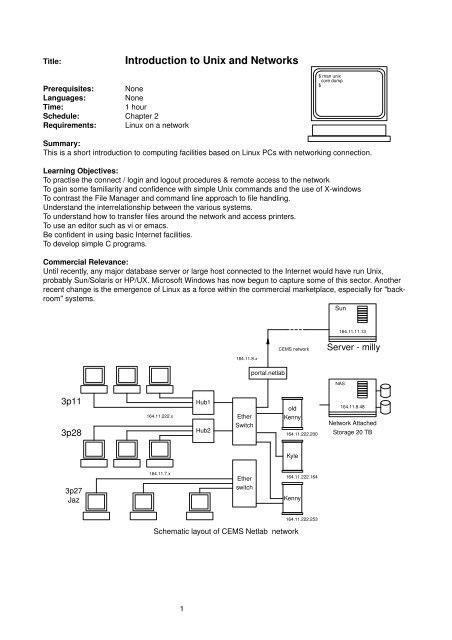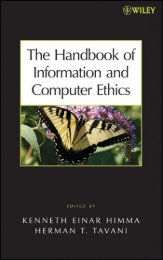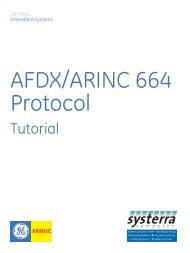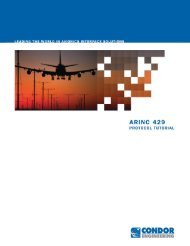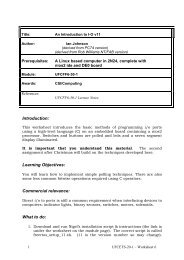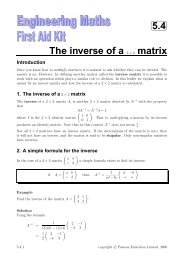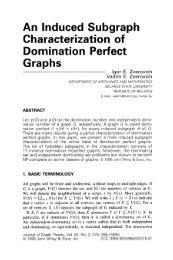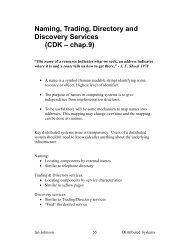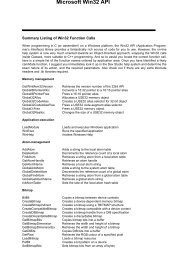Introduction to Unix and Networks
Introduction to Unix and Networks
Introduction to Unix and Networks
Create successful ePaper yourself
Turn your PDF publications into a flip-book with our unique Google optimized e-Paper software.
Title: <strong>Introduction</strong> <strong>to</strong> <strong>Unix</strong> <strong>and</strong> <strong>Networks</strong><br />
Prerequisites: None<br />
Languages: None<br />
Time: 1hour<br />
Schedule: Chapter 2<br />
Requirements: Linux on a networ k<br />
$man unix<br />
core dump<br />
$<br />
Summar y:<br />
This is a shortintroduction <strong>to</strong> computing facilities based on Linux PCs with networ king connection.<br />
Learning Objectives:<br />
To practise the connect / login <strong>and</strong> logout procedures & remote access <strong>to</strong> the networ k<br />
To gain some familiar ity <strong>and</strong> confidence with simple <strong>Unix</strong> comm<strong>and</strong>s <strong>and</strong> the use of X-windows<br />
To contrast the File Manager <strong>and</strong> comm<strong>and</strong> line approach <strong>to</strong> file h<strong>and</strong>ling.<br />
Underst<strong>and</strong> the interrelationship between the var ious systems.<br />
To underst<strong>and</strong> how <strong>to</strong>transfer files around the networ k <strong>and</strong> access printers.<br />
To use an edi<strong>to</strong>r such as vi or emacs.<br />
Be confident in using basic Internet facilities.<br />
To dev elop simple C programs.<br />
Commercial Relevance:<br />
Until recently,any major database server orlarge host connected <strong>to</strong> the Internet would have run <strong>Unix</strong>,<br />
probably Sun/Solaris or HP/UX. Microsoft Windows has now begun <strong>to</strong> capture some of this sec<strong>to</strong>r. Another<br />
recent change is the emergence of Linux as a force within the commercial marketplace, especially for "backroom"<br />
systems.<br />
3p11<br />
3p28<br />
3p27<br />
Jaz<br />
164.11.222.x<br />
164.11.7.x<br />
Hub1<br />
Hub2<br />
164.11.8.x<br />
Ether<br />
Switch<br />
Ether<br />
switch<br />
por tal.netlab<br />
CEMS networ k<br />
old<br />
Kenny<br />
Kyle<br />
Kenny<br />
Schematic layout of CEMS Netlab networ k<br />
1<br />
164.11.222.200<br />
164.11.222.164<br />
164.11.222.253<br />
Sun<br />
164.11.11.13<br />
Ser ver - milly<br />
NAS<br />
164.11.8.48<br />
Networ k Attached<br />
S<strong>to</strong>rage 20 TB
The role of an operating system, such as <strong>Unix</strong> or Windows-XP, is<strong>to</strong>assist the user <strong>and</strong> protect the hardware.<br />
Operating systems are large, complex programs, orgroups of programs, designed <strong>to</strong> help application<br />
programs employ the resources of the computer more securely <strong>and</strong> efficiently. With multi-user systems, <strong>and</strong><br />
ev en single-user multi-tasking systems, the allocation, arbitration <strong>and</strong> control of shared resources is a<br />
pr imary function. When the computer is shared between a number of users, the problem of data security<br />
becomes paramount. More <strong>and</strong> more, the operating system provides convenient access <strong>to</strong> a networ k <strong>and</strong> the<br />
Inter net beyond. <strong>Unix</strong> remains an important commercial example, <strong>and</strong> has also attracted more enthusiasts<br />
with the introduction of the freely distributed Linux version.<br />
1. Logging on<br />
This wor ksheet requires you <strong>to</strong> wor k with Linux, so you may have <strong>to</strong>reboot the PC. Check <strong>to</strong>see if your PC<br />
needs <strong>to</strong> be turned on, or just rebooted if it is currently running Windows. Log on with your CEMS user id<br />
<strong>and</strong> netlab password which may bedifferent from that for the main networ k. Note that <strong>Unix</strong> respects the<br />
upper/lowercase distinction, so be careful entering the allocated password. The password scheme for Netlab<br />
Linux is separate from the main <strong>Unix</strong> <strong>and</strong> PC networ ks in the rest of the University. Yes, you could end up<br />
having <strong>to</strong> remember 4 distinct passwords! At the last count, I discovered that I was remembering 13 different<br />
passwords <strong>and</strong> identity codes. How ever, at UWE, you can set them all the same value if you wish.<br />
Although it would be nice <strong>to</strong> have a single password for all UWE facilities: librar y, email, ITS computing,<br />
CEMS computing, WiFi connection, remote login from home, web page administration, this has not yet been<br />
achieved <strong>and</strong> you will still need <strong>to</strong> remember several distinct passwords. You can set most of these <strong>to</strong> the<br />
same value if that suits you. But do not overlook the need for effective, appropr iate secur ity. Because the<br />
university takes a ver y ser ious view onplager ism (copying). Allowing others <strong>to</strong> get access <strong>to</strong> your personal<br />
files can lead you in<strong>to</strong> deep trouble with UWE. Certainly NEVER allow others the right <strong>to</strong> send emails from<br />
your account when you are not present.<br />
Changing a <strong>Unix</strong> password <strong>to</strong> some more personally memorable item is easy, but make sure you do<br />
remember your new password. For security reasons it is good practice <strong>to</strong> include a non-letter (number or<br />
punctuation) in the password <strong>to</strong> discourage "dictionary scanning". Car numbers are a good source, but don’t<br />
be daft <strong>and</strong> use your current number plate.<br />
Tr y guessing a friend’s password, <strong>and</strong> note down your strategies. Most malign hacking involves reading a<br />
password from a PostIT note stuck <strong>to</strong>anadmin terminal, or given over the phone.<br />
Av oid guessable items for your own password!<br />
We usually recommend that you do not change the original, unmemorable passwords immediately. Wait until<br />
you are more familiar with the UWE system. But this is the way you do it:<br />
rob@kenny> passwd<br />
Please enter your old password:<br />
Please enter your new password:<br />
Please enter your password again:<br />
Your password has now been changed.<br />
rob@kenny><br />
When you login (or start anew shell), the <strong>Unix</strong> operating system will try <strong>to</strong>execute setup instructions held in<br />
anumber of st<strong>and</strong>ard script files. Typically these instructions will initialize some environment var iables, such<br />
as PS1, PATH<strong>and</strong> TERM. Look in<strong>to</strong> the following files, note they are hidden fromls by the leading ".". You<br />
must usels -al or select [View] -> [Show Hidden Files] for the file browser.<br />
1 /etc/profile at login, by the initial shell<br />
2 ~/.bash_profile<br />
3 ~/bash_login<br />
4 ~/.profile<br />
~/.bashrc at each new shell start up<br />
~/bash_logout by initial shell at logout<br />
There are 3 files you really need <strong>to</strong> underst<strong>and</strong> when cus<strong>to</strong>mizing the bash shell: /etc/profile, ~/.bash_profile,<br />
<strong>and</strong> ~/.bashrc. Inspect /etc/profile (more /etc/profile which holds global initialization comm<strong>and</strong>s for<br />
ev ery user. Each user can have an personalised ~/.bash_profile which is executed only at login. It is NOT<br />
executed for each shell, only the login shell. However, ~/.bashrc is executed for each new shell except the<br />
2
login shell. It is recommened that you put all your special shell cus<strong>to</strong>mizations in<strong>to</strong> your .bashrc file, <strong>and</strong> set<br />
.bash_profile <strong>to</strong> call .bashrc with the comm<strong>and</strong>:source ~/.bashrc.<br />
The most important set-up action is <strong>to</strong> initialise thePATH variable. This tells the <strong>Unix</strong> shell where <strong>to</strong> find<br />
executable programs. Ifitisnot set up, noprograms can be found, or run. Quite tragic. Now look at its value<br />
for your session:<br />
# printenv PATH<br />
/usr/local/bin:/usr/bin:/bin:/usr/bin/X11:/usr/games:$HOME/bin<br />
#<br />
To add another direc<strong>to</strong>ry, such as your current one (indicated by the .), <strong>to</strong> the PATH,<br />
you could use the following:<br />
# export PATH=${PATH}:.<br />
look here<br />
# printenv PATH<br />
/usr/local/bin:/usr/bin:/bin:/usr/bin/X11:/usr/games:$HOME/bin:.<br />
#<br />
Note the use of { } <strong>to</strong> define clearly what the var iable name is. Otherwise the $ prefix could extend in scope <strong>to</strong><br />
the end of the line. Alter natively, you could addexport PATH=${PATH}:. <strong>to</strong> your.bash initialization file.<br />
As an exper iment, tr y clear ing PATH, <strong>and</strong> see what results. But before you do it, make sure you know how <strong>to</strong><br />
reset it:<br />
COMMENTS<br />
# OLDPATH=$PATH save value in PATH<br />
# PATH="" clear PATH<br />
# emacs tr y <strong>to</strong> run an application<br />
-bash: emacs: No such file or direc<strong>to</strong>ry error from Linux !!<br />
# PATH=$OLDPATH res<strong>to</strong>re PATH’s value<br />
# emacs & all OK now again<br />
#<br />
When you are registered on a <strong>Unix</strong> system as a user, you are allocated a UID (user identity number). Also<br />
you can join groups of other users. Use the comm<strong>and</strong>swhoami <strong>and</strong>id <strong>to</strong> find out who you are. Once logged<br />
in, you maybeable <strong>to</strong>switch user identity usingsu, but at UWE this is a privileged comm<strong>and</strong>, limited <strong>to</strong><br />
administra<strong>to</strong>rs only.<br />
2. The <strong>Unix</strong> Filesystem<br />
There is a general pattern which all <strong>Unix</strong> file system hierarchies keep <strong>to</strong>, although it does var y abit when<br />
moving between HP/UX, Solaris, <strong>and</strong> all the Linuxes. When logged in, list the root direc<strong>to</strong>ry ofyour desk<strong>to</strong>p<br />
machine:<br />
# ls -al /<br />
bin/ etc/ initrd/ local/ proc/ sys/ tmp/ vmlinuz@<br />
boot/ floppy/ initrd.img@ mnt/ root/ tftpboot/ usr/<br />
dev/ home/ lib/ opt/ sbin/ tftpboot.tgz var/<br />
#<br />
The direc<strong>to</strong>ry patter n is best expressed in a tree diagram, each of the nodes also elaborate the hierarchy<br />
fur ther,until the files themselves are reached. Here is the <strong>to</strong>p level direc<strong>to</strong>r y tree:<br />
bin boot dev etc home local mnt proc sbin tmp usr var<br />
Take a look in each of the <strong>to</strong>p level subdirec<strong>to</strong>r ies <strong>and</strong> decide what kind of files, used for what purpose, are<br />
s<strong>to</strong>red there:cd /bin; ls -al<br />
3<br />
/
3. The network<br />
The UWE CEMS faculty has a main networ k, <strong>and</strong> an exper imental networ k called Netlab. The main networ k<br />
has some 17 subnets <strong>and</strong> 500 hosts (notably milly the main Sun multiprocessor), including all the staff<br />
rooms,student PC <strong>and</strong> <strong>Unix</strong> labs, <strong>and</strong> so becomes ver y complex. The much smaller exper imental networ k<br />
only covers 3p11, 3p27, 2p28, 2n24 <strong>and</strong> the local servers, notably kenny, asinthe preceding diagram.<br />
This networ k diagram only shows the interconnectivity of the var ious hosts accessible from the Netlab<br />
networ k. The main University networ k is really <strong>to</strong>o complex <strong>to</strong>bother with, but from the users’ point of viewit<br />
all acts like agigantic central switch, routing packets between all the subnets.<br />
The distribution <strong>and</strong> routing of data packets along local area networ ks (LAN) <strong>and</strong> out across the Internet is<br />
based on the TCP/IP pro<strong>to</strong>cols. These pro<strong>to</strong>cols specify data packet for mats, comm<strong>and</strong> codes, responses<br />
<strong>and</strong> conventions. They were originally devised as part ofthe US Department of Defense (DOD) computer<br />
communications research program <strong>and</strong> were intended <strong>to</strong> allow easy exchange of data within the US<br />
Research <strong>and</strong> Military community. They became the premier st<strong>and</strong>ard mainly because they wor ked well <strong>and</strong><br />
were readily available through the <strong>Unix</strong> operating system.<br />
The var ious networ k IP numbers are inserted on<strong>to</strong> the first diagram next <strong>to</strong>the hosts <strong>and</strong> LAN segments<br />
(subnets) <strong>to</strong> which they apply. The quad-dotted IP numbers are like telephone numbers, they allow you <strong>to</strong><br />
refer <strong>to</strong> subnets <strong>and</strong> individual connected devices, such as PCs, printers, routers. Each device is allocated a<br />
globally unique 32 bit address number, which is normally written in quadruple dotted notation. For my<br />
workstation, called olves<strong>to</strong>n, the IP number is written as 164.11.253.36. This is actually:<br />
10100100000010111111110100100100 in binary, summar ized in hex for mat as: A40BFD24 . You can see<br />
the advantage <strong>to</strong> having friendly names such as milly <strong>and</strong> kenny allocated <strong>to</strong> each computer!<br />
In 3p11 the host numbers are allocated <strong>to</strong> the PCs in this way:<br />
164.11.222.01,<br />
164.11.222.02,<br />
164.11.222.03, <strong>and</strong> so on.<br />
Note that the left h<strong>and</strong> "164.11" is the University domain address on the internet. The "222" is the subnet<br />
address for the Netlab LAN, <strong>and</strong> the righth<strong>and</strong>, least significant numbers such as "02" refer uniquely <strong>to</strong><br />
individual computers. Asalready explained, hosts are normally referred <strong>to</strong> by name, such as kenny or milly.<br />
The official name <strong>and</strong> IP number can be used interchangeably in most circumstances<br />
Find out the name <strong>and</strong> IP number of your current wor kstation by usinghostname -i orifconfig,<br />
(on XP useipconfig).<br />
Youcan trytesting for other hosts on the net by usingping. Ping also tells you how long it takes for a<br />
packet <strong>to</strong>reach its destination.<br />
rob@kenny> ping milly<br />
PING milly.cems.uwe.ac.uk (164.11.11.13): 56 octets data<br />
64 octets from 164.11.11.13: icmp_seq=0 ttl=253 time=0.6 ms<br />
64 octets from 164.11.11.13: icmp_seq=1 ttl=253 time=0.5 ms<br />
64 octets from 164.11.11.13: icmp_seq=2 ttl=253 time=0.5 ms<br />
64 octets from 164.11.11.13: icmp_seq=3 ttl=253 time=0.5 ms<br />
64 octets from 164.11.11.13: icmp_seq=4 ttl=253 time=0.6 ms<br />
64 octets from 164.11.11.13: icmp_seq=5 ttl=253 time=0.5 ms<br />
ˆC<br />
--- milly.cems.uwe.ac.uk ping statistics ---<br />
7packets transmitted, 6 packets received, 0% packet loss<br />
round-trip min/avg/max = 0.5/0.5/0.6 ms<br />
rob@kenny><br />
4. Logging out<br />
Use [CNTRL/ALT/DEL] <strong>and</strong> selectlogout for nor mal exit. Don’t turn off the power because then it takes<br />
longer for the next student <strong>to</strong> log on. Don’t forget <strong>to</strong> logout! There is a screen/key-lock facility if you want <strong>to</strong><br />
pop out <strong>to</strong> the loo.<br />
4
5. <strong>Unix</strong> basic comm<strong>and</strong>s<br />
All self-respecting computers have a program called the Operating System <strong>to</strong> organize the facilities, protect<br />
the hardware from ignorant/malicious programs <strong>and</strong> generally help the user <strong>to</strong> have a good time. <strong>Unix</strong> is one<br />
of the most stable Operating Systems currently available. Sun’s Solar is, HP/UX <strong>and</strong> Linux are three well<br />
known versions of <strong>Unix</strong>. Most of the fastest wor kstations have been designed <strong>to</strong> run <strong>Unix</strong> because of its<br />
facility <strong>to</strong> deal with multi-processor hardware. Windows has not yet demonstrated long-term success in this<br />
niche, itisalso some-what cramped by the 32-bit Pentium, whereas the newer 64-bit CPUs (Alpha, ARM,<br />
HP/PA, Itanium) are already running <strong>Unix</strong>.<br />
<strong>Unix</strong> is a <strong>to</strong>ol kit. There are hundreds of comm<strong>and</strong>s <strong>and</strong> <strong>to</strong>ols <strong>to</strong> help the knowledgeable programmer. Many<br />
of the original, cryptic comm<strong>and</strong> line <strong>to</strong>ols have now been repackaged for the X-windows <strong>and</strong> so are<br />
conveniently GUI-based. To s<strong>to</strong>p a <strong>Unix</strong> process (a running program) try using[CNTRL C]. This usually<br />
works, else you must identify its process number, using theps comm<strong>and</strong>, <strong>and</strong> use this withkill.<br />
ls direc<strong>to</strong>r y file listing,ls -al for more details<br />
ls list current direc<strong>to</strong>ry<br />
ls -al ~ detailed listing of home direc<strong>to</strong>ry<br />
ls / list <strong>to</strong>p level, root direc<strong>to</strong>ry<br />
ls -al Projects list contents of subdirec<strong>to</strong>ry, Projects<br />
ls /tmp/*.ps list names of all PostScr ipt file in /tmp<br />
cat ormore list contents of a text file<br />
mkdir ~/Newdir create a new subdirec<strong>to</strong>r y<br />
rmdir<br />
cd /tmp change current wor king direc<strong>to</strong>r y<br />
rm junkfile remove/delete a file<br />
cp oldfile newfile copy afile<br />
mv oldfile newfile move a file<br />
pwd pr int current wor king direc<strong>to</strong>r y<br />
hostname pr int host name,hostname -i for IPnumber<br />
ps list processes,ps -AF for all processes<br />
kill pid kill a process<br />
man kill Help from <strong>Unix</strong> about thekill comm<strong>and</strong><br />
xclock & display aclock, releasing the keyboard<br />
find ~ -name prog.c -print find a file<br />
grep -rs "marks" ~ locate any ofmyfiles referr ing <strong>to</strong> marks<br />
date<br />
wc file.txt letter, word & liner count<br />
whereis xeyes locate an executable<br />
file something test the file-type of a file called something<br />
So, boot up a PC in<strong>to</strong> Linux, start the X windowing system if necessary from the comm<strong>and</strong> line by typing:<br />
startx,then use the RMB <strong>to</strong> select shells->xterm from the main window panel. This allows you <strong>to</strong> startup<br />
comm<strong>and</strong> windows <strong>and</strong> type in comm<strong>and</strong>s <strong>to</strong> <strong>Unix</strong>. Try these example commamds:<br />
ps list your processes with PID number<br />
ps -FA<br />
hostname -i; hostname -d<br />
/sbin/ifconfig -a another way <strong>to</strong> find out your local IP number<br />
xeyes & star t xe y es inthe background, note the "&"<br />
ps<br />
kill xxx inser t the PID number for the xeyes process<br />
xeyes &<br />
kill ‘ps | gawk ’/xeyes/ {print $1}’‘ anice <strong>Unix</strong> pipe<br />
xhost +<br />
5
6. Printing<br />
xterm -T kenny -n kenny &<br />
change <strong>to</strong> new window<br />
ssh -X yourid@kenny<br />
Password: *******<br />
export DISPLAY=3p11-10.netlab.cems.uwe.ac.uk tell kenny your screen<br />
emacs &<br />
(find . -name "fred*" -print >> ~/foundit ) >& /dev/null &<br />
background search for a file called fred-something<br />
grep -rs "strncmp" /usr/include<br />
search for a function definition in header files<br />
ypcat passwd | grep -i "williams"<br />
using the <strong>Unix</strong> NIS/yp password file, locate a student<br />
When you want <strong>to</strong> print from a Linux system on the networ k, you can uselpstat <strong>to</strong> check printer<br />
availability,lpq <strong>to</strong> check the queue length, <strong>and</strong>lp <strong>to</strong> send a file <strong>to</strong> the chosen printer. The printers owned by<br />
ITS use the Pharos billing system which requires you <strong>to</strong> pay per sheet. A document <strong>to</strong> be printed is queued<br />
at the print station until you go <strong>and</strong> specially login at the station <strong>and</strong> release the print job. Uselprm <strong>to</strong><br />
remove your job waiting on a printer’s queue.<br />
rob@kenny> lpstat -p<br />
printer bw_plain is idle. enabled since Jan 01 00:00<br />
printer col_plain is idle. enabled since Jan 01 00:00<br />
printer netlab is idle. enabled since Jan 01 00:00<br />
printer staffcol is idle. enabled since Jan 01 00:00<br />
printer staffps is idle. enabled since Jan 01 00:00<br />
rob@kenny:~$<br />
rob@kenny> lp -dnetlab world.c<br />
request id is netlab-159 (1 file(s))<br />
rob@kenny><br />
rob@kenny> lpq -Pnetlab<br />
netlab is ready <strong>and</strong> printing<br />
Rank Owner Job File(s) Total Size<br />
active rob 160 client.c 8192 bytes<br />
rob@kenny><br />
The following is a useful comm<strong>and</strong> line for printing wide, commented source code. Look up the manual page<br />
(man enscript) <strong>and</strong> find out what each of the 7 flag options achieve . Note that it should all be typed in<strong>to</strong><br />
<strong>Unix</strong> on a single line. You could use this for your programming assignment listings.<br />
enscript -dnetlab -c -r --header=’$n|%W|Page $% of $=’ -n2<br />
-Dduplex:false -fCourier10 prog.c<br />
7. Remote access<br />
Students maybeable <strong>to</strong>login <strong>to</strong> the <strong>Unix</strong> hosts or wor kstations from anywhere, through broadb<strong>and</strong> or<br />
through dial up modems. Remote sessions via the Internet are routed, for security reasons, through a firewall<br />
host. To use this facility for inward remote login, you will have <strong>to</strong> register with the Help Desk <strong>and</strong> obtain an<br />
ssh password. I login from home using the secure shell (ssh) comm<strong>and</strong>:<br />
rob> ssh r-williams@gateway.uwe.ac.uk<br />
r-williams@gateway.uwe.ac.uk’s password:<br />
Then I telnet or ssh <strong>to</strong> milly <strong>to</strong> see my files, orssh <strong>to</strong> kenny for Netlab access. You cannot achieve much on<br />
the gateway machine itself, but it does run the ftp demon, so it can act as a forwarding station for off-site file<br />
transfers.<br />
6
The utilitynslookup can be useful when you are trying <strong>to</strong> find domain names or IP numbers. Check out the<br />
manual page for nslookup, <strong>and</strong> try:nslookup yahoo.co.uk. Itcan be useful when trying <strong>to</strong> set up a<br />
session from home <strong>to</strong> know some IP numbers.<br />
yahoo.co.uk 217.12.3.11<br />
blueyonder.co.uk 62.30.31.86<br />
google.co.uk 66.249.93.104<br />
milly 164.11.11.13<br />
kenny 164.11.222.253<br />
kyle 164.11.222.164<br />
nas 164.11.8.48<br />
The two applicationstelnet <strong>and</strong>ssh provide remote login capability. But if you want <strong>to</strong> transfer files<br />
between computers there are several alter natives which can be exploited, besides the flash stick, of course.<br />
8. Flash sticks<br />
•dual login <strong>and</strong> use desk<strong>to</strong>p cut & paste facilities <strong>to</strong> copy text across<br />
•ftp or sftp (file transfer pro<strong>to</strong>col)<br />
•NFS file expor t/sharing<br />
•web browser such as IE or Firefox using http <strong>and</strong> SAVE AS the file<br />
•email an attachment <strong>to</strong> yourself<br />
To use a flash stick, CDROM or floppy inaPCrunning <strong>Unix</strong>, you have <strong>to</strong> notify the computer that a newfile<br />
system is available by using themount comm<strong>and</strong>:<br />
7
Inser t your flash stick, <strong>and</strong> use themount /media/flash comm<strong>and</strong>. On my machine the mount point is<br />
/media/DISGO due <strong>to</strong> some problems with its file system. Then inspect the flash stick direc<strong>to</strong>r y using:ls<br />
-al /media/flash. Remember <strong>to</strong>umount /media/flash before removing it from the computer. The<br />
reason you have <strong>to</strong> tell the system when you intend <strong>to</strong> withdraw the memory stick isthat often the new data<br />
is held in RAM cache, <strong>and</strong> not immediately written <strong>to</strong> the flash memory. Thus you have <strong>to</strong> flush the cache<br />
before removing the stick. Watch the flash stick LED for activity. <strong>Unix</strong> also has thesync comm<strong>and</strong> <strong>to</strong> flush<br />
all buffers before turning off the power.<br />
In large networ ks, itiscommon for data <strong>and</strong> executable binaries <strong>to</strong> be distributed amongst several hosts.<br />
This is made possible by the Networ k Filing System (nfs) provided by Sun Microsystems. This allows a user<br />
<strong>to</strong> see remote files as if they were s<strong>to</strong>red on the local hard disk. Microsoft offers a similar facility known as<br />
"shares". To get an indication of the usage of the nfs cross-mounting facility use thedf -k utility, which<br />
gives more infor mation thanmount. Below ispar t of the df -k results for my wor kstation:<br />
rwilliam@olves<strong>to</strong>n [87] df -k<br />
Filesystem kbytes used avail capacity Mounted on<br />
/dev/hda2 34177192 3261124 30916068 10% /<br />
tmpfs 254096 0 254096 0% /dev/shm<br />
/dev/hda3 8770392 4 8770388 1% /shared<br />
tmpfs 10240 700 9540 7% /dev<br />
nas:/nas 1756463104 215384496 1541078608 13% /nas<br />
/dev/hdc 620876 620876 0 100% /media/cdrom0<br />
rwilliam@olves<strong>to</strong>n [88]<br />
Youcan see mention of the partitions on the local drives hda2 <strong>and</strong> hda3, also the remote mounted nas<br />
device which expor ts its file systems <strong>to</strong> all the local computers for access. This makes them appear the same<br />
as locally s<strong>to</strong>red files. Note also the last entry which shows a removeable CD (Burks) has also been mounted<br />
for access.Inlarge sites, files are distributed across many different computers. But more <strong>and</strong> more, user<br />
data files (home direc<strong>to</strong>ries) are held on a Networ k Attached S<strong>to</strong>rage (NAS) device which efficiently<br />
manages terabytes (T, 2 40 ,or10 12 )ofs<strong>to</strong>rage.<br />
9. <strong>Unix</strong> & MS Windows-XP in P,Q&NBlock<br />
There are several distinct subnets <strong>and</strong> computing labs set up in different lab blocks. You must get used <strong>to</strong><br />
their differences <strong>and</strong> individual quirks if you want <strong>to</strong> gain the maximum benefit from your time at university.<br />
Take a stroll around the campus site <strong>to</strong> locate the different labs.<br />
The ability for <strong>Unix</strong> <strong>to</strong> h<strong>and</strong>le data for Windows, using the SMB file server program means that a single host<br />
can s<strong>to</strong>re files for both <strong>Unix</strong> <strong>and</strong> XP. Atthe moment a large ( 1.7 TB) networ k s<strong>to</strong>rage array perfor ms that<br />
function.<br />
10. X11R6, X-windows<br />
<strong>Unix</strong> originally did not have a GUI interface. Itcould only be accessed from the comm<strong>and</strong> line, through a<br />
comm<strong>and</strong> line interface (CLI), normally called the Shell. Now itisnor mal <strong>to</strong> install the X-windows suite of<br />
programs on <strong>to</strong>p of <strong>Unix</strong> <strong>to</strong> provide full WIMP/GUI facilities. Itisimpor tant <strong>to</strong> underst<strong>and</strong> that X-windows<br />
suppor ts distr ibuted processing in addition <strong>to</strong> a graphical display facility.<br />
If when you login, <strong>Unix</strong> does not au<strong>to</strong>matically evoke the X11 GUI, you can often start itmanually with:<br />
startx.<br />
Nowadays, without X-windows, <strong>Unix</strong> looks ver y quiet <strong>and</strong> unexciting. This is the same situation you find when<br />
running a MicroSoft comm<strong>and</strong> prompt (C>) orDOS session. Occasionally you may have <strong>to</strong>log in<strong>to</strong> "vanilla"<br />
version of <strong>Unix</strong>. On Linux this is possible using the F1-F7 keys with [CNTL][ALT], but only one of these<br />
sessions can run X11, this is usually on F7. Try[CNTL][ALT]F2. Login <strong>to</strong> a parallel session <strong>and</strong> checkon<br />
your processes. You should be able <strong>to</strong> see processes from the previous processes. Logout <strong>and</strong> hit<br />
[CNTL][ALT]F7 <strong>to</strong> return <strong>to</strong>the X11 session. X-windows often involves 3 separate processes: an X Client<br />
application, a Screen Server, <strong>and</strong> X-window Manager. The client application is the user program that wants<br />
<strong>to</strong> displaysomething. The Screen Server runs the .... screen, rendering the display correctly under the<br />
control of X pro<strong>to</strong>col packets. Finally, the X-window Manager organises multiple window sessions on a single<br />
screen, taking events <strong>and</strong> directing them <strong>to</strong> the correct client processes. There are several alter native<br />
8
managers: twm, olwm, kwin,<br />
Pr int Ser ver<br />
client<br />
application<br />
Window<br />
manager<br />
Screen Server<br />
X-windows Client-Server couplets wor king across a networ k<br />
Note that the Client <strong>and</strong> Manager proceses do not need <strong>to</strong> be running on the local machine. Infact, it is<br />
common <strong>to</strong> distribute X applications around the networ k, in order <strong>to</strong> exploit the available processing <strong>and</strong><br />
s<strong>to</strong>rage facilities. With such a powerful <strong>and</strong> flexible system, there is a real danger of unwanted data arriving<br />
on your screen. The first level defence is <strong>to</strong> s<strong>to</strong>p all "foreign" hosts from sending data <strong>to</strong> your screen:<br />
$xhost -<br />
This s<strong>to</strong>ps all the fun! So normally you would open up <strong>to</strong> trusted remote machines or friends:<br />
$xhost +kenny +rwilliam +164.11.222.164<br />
With this arrangement, new windows can be opened on your machine from anyone running on kenny orkyle,<br />
or rwilliam from any machine.<br />
If you are running a client X application (in fact practically any <strong>Unix</strong> program) <strong>and</strong> wish <strong>to</strong> display remotely,<br />
the client process has <strong>to</strong> send X data acros the networ k <strong>to</strong> the selected target screen. This can be done be<br />
setting theDISPLAY environment var iable on the client machine:<br />
$export DISPLAY=target_machine:0.0<br />
The term target_machine can be either the IP or the domain name of the machine This will of course mean<br />
that all o/p will get redirected <strong>to</strong>the same remote machine, soanalter native is<strong>to</strong>use an X comm<strong>and</strong> line<br />
parameter when starting the application:<br />
$xeyes -display 164.11.253.36:0.0<br />
Following this introduction <strong>to</strong> parameters for X applications, there is also font control.<br />
$emacs -font -*-helvetica-*-r-*-*-*-120-*-*-*-*-*-* &<br />
The font name is <strong>to</strong>o complex <strong>to</strong>type in, even though only 3 of the fields are necessary. Use the font browser<br />
xfontsel <strong>to</strong> view the available fonts, copy the name specifier using the [select] but<strong>to</strong>n, <strong>and</strong> paste it back on<strong>to</strong><br />
the comm<strong>and</strong> line using the middle mouse but<strong>to</strong>n.<br />
$xfontsel &<br />
9
11. KDE desk<strong>to</strong>p environment<br />
The K Desk<strong>to</strong>p Environment, usually abbreviated <strong>to</strong> KDE, is one of several graphical desk<strong>to</strong>ps for Linux. The<br />
main alternative isGnome. Generally, desk<strong>to</strong>p GUIs offer everything you need <strong>to</strong> wor k with on a daily<br />
basis.But occasionally you still need <strong>to</strong> use the comm<strong>and</strong> line <strong>to</strong> obtain the required facility. The typical KDE<br />
desk<strong>to</strong>p consists of several par ts: Apanel at the bot<strong>to</strong>m of the screen, used <strong>to</strong> start applications <strong>and</strong> switch<br />
between desk<strong>to</strong>ps. Itcontains the K menu, a large icon which displays a menu ofapplications which start<br />
when LMB clicked. A taskbar, bydefault running across the bot<strong>to</strong>m of the screen, is used <strong>to</strong> manage<br />
currently running applications. Click onanapplication on the taskbar <strong>to</strong> switch <strong>to</strong> the application. The<br />
desk<strong>to</strong>p itself, can display icons for frequently used applications. KDE provides multiple desk<strong>to</strong>ps, each of<br />
which has its own windows. Click onthe numbered but<strong>to</strong>ns on the panel <strong>to</strong> switch between desk<strong>to</strong>ps.<br />
Applications can be started by:<br />
Selecting a desk<strong>to</strong>p icon,<br />
Selecting the name from the main KDE menu (bot<strong>to</strong>n left corner),<br />
Typing the name in<strong>to</strong> a comm<strong>and</strong> window, such as konsole or xterm.<br />
Typing the name in<strong>to</strong> the Tool Bar Application Launcher window,<br />
RMB click ondesk<strong>to</strong>p, select Run.<br />
KDE is constructed using the Qt X-windows widget librar y, <strong>and</strong> comes with many useful X applications, such<br />
as the browser Konqueror, Konsole terminal, Kpackage package manager <strong>and</strong> many more. Anon-line help<br />
system is available from the <strong>to</strong>olbar as a life belt icon. This shows the KDE help files as well as the normal<br />
UNIX man pages. The Linux HOWTOs are also available on kenny at/usr/share/doc.<br />
12. <strong>Unix</strong> BASH shell<br />
A<strong>Unix</strong> shell, such as bash, sh, csh, ksh or tcsh, is a program which moni<strong>to</strong>rs the comm<strong>and</strong> line keyboard<br />
input, interprets the instructions <strong>and</strong> outputs results <strong>to</strong> the screen. It runs when you start acomm<strong>and</strong><br />
window (konsole or xterm). Because everybody’s prompt is different in this sheet we will try <strong>to</strong>use the old $<br />
sign as the <strong>Unix</strong> prompt. Note that you can change your line prompt if you want <strong>to</strong>, when using the bash<br />
shell:<br />
$<br />
$ export PS1="hi> "<br />
hi ><br />
The user interface program, or Comm<strong>and</strong> Line Interface (CLI) isknown as the shell. There are several<br />
alter native shells that the user can choose from:<br />
sh original Bourne shell, written by Steve Bour ne<br />
csh C shell written by Steve Joy<br />
ksh Kor n shell, often found on HP equipment<br />
tcsh tennex shell, my favour ite<br />
bash born again shell, used with Linux<br />
10
Just type inksh orbash <strong>to</strong> swap <strong>to</strong>another shell. You can return <strong>to</strong>the previous shell withexit. The<br />
bash shell is often found running on Linux <strong>and</strong> is like the old Bourne shell. It does things a bit differently <strong>to</strong><br />
the csh, so <strong>to</strong> change your bash screen prompt you need <strong>to</strong> type:PS1="here> ". Onthe ksh the same<br />
would be You may find a short prompt is preferable.<br />
Some shells offer helpful facilities for users, such as au<strong>to</strong> completion, comm<strong>and</strong> line editing <strong>and</strong><br />
comm<strong>and</strong> line his<strong>to</strong>ry. Iuse bash, tsh or ksh <strong>to</strong> get comm<strong>and</strong> line editing in the style of the emacs edi<strong>to</strong>r.<br />
his<strong>to</strong>r y au<strong>to</strong> editing<br />
list previous next completion<br />
bash his<strong>to</strong>ry ˆP ˆN TAB emacs<br />
tcsh his<strong>to</strong>ry ˆP ˆN TAB emacs<br />
csh his<strong>to</strong>ry !! TAB ed<br />
!-1 !emac<br />
!42<br />
!mkd<br />
sh TAB none<br />
ksh fc -l r<br />
his<strong>to</strong>r y fc -e emacs 1<br />
ksh -o emacs his<strong>to</strong>r y ˆP ˆN TAB(Linux) emacs<br />
The character erase key can sometimes get lost. It can often be bound <strong>to</strong> either [DEL} or [BS}, you can set<br />
erase <strong>to</strong> whatever you want:<br />
$ tset -e[BS]<br />
$erase set <strong>to</strong> Cntrl-H<br />
$<br />
Another feature of <strong>Unix</strong> is the PA TH. This "environment var iable" holds a list of direc<strong>to</strong>ries where<br />
programmes can be found.<br />
rob@kenny> printenv PATH<br />
/usr/local/bin:/usr/bin:/bin:/usr/X11R6/bin:/usr/games:/usr/local/<br />
jdk1.3.1_01/bin:/usr/local/mysql/bin:/usr/local/samba/bin:.:/opt/<br />
gnome/bin:/usr/share/texmf/bin:/usr/openwin/bin<br />
Adding another bin location <strong>to</strong> the PATHlist:<br />
rob@kenny> export PATH=${PATH}:/home/netlab/rob/bin<br />
rob@kenny> printenv PATH<br />
/usr/local/bin:/usr/bin:/bin:/usr/X11R6/bin:/usr/games:/usr/local/<br />
jdk1.3.1_01/bin:/usr/local/mysql/bin:/usr/local/samba/bin:.:/opt/<br />
gnome/bin:/usr/share/texmf/bin:/usr/openwin/bin:/home/netlab/rob/bin<br />
If you try<strong>to</strong>run a program <strong>and</strong> <strong>Unix</strong> gives the error "not found", it might mean that the program iss<strong>to</strong>red in a<br />
direc<strong>to</strong>r y which is not mentioned in the current PATHlist. If you already know where the executable is s<strong>to</strong>red<br />
on disk you can simply sort i<strong>to</strong>ut by typing in the full pathname, such as/usr/sbin/ping, oradding the<br />
direc<strong>to</strong>r y <strong>to</strong> your PATHlist,setenv PATH=${PATH}:/usr/sbin, Ifhow ever you have no idea where in the<br />
CEMS NFS networ k the code might reside - you have a bit of a problem! Removing an entry from the PATH<br />
is a bit more sophisticated, involving comm<strong>and</strong> piping <strong>and</strong> substitution which we will encounter again, later in<br />
this wor ksheet:<br />
$ printenv PATH<br />
/usr/bin:/bin:/usr/bin:/usr/local/bin:/usr/X11R6/bin/:/usr/games:/home/rob/bi<br />
$ export DISPLAY=‘echo $PATH | sed ’s#/usr/games:##g’‘<br />
$ printenv PATH<br />
/usr/bin:/bin:/usr/bin:/usr/local/bin:/usr/X11R6/bin/:/home/rob/bin:.<br />
Or you could just use the comm<strong>and</strong> line editing facilities <strong>to</strong> achieve the same amendment.<br />
11
At <strong>Unix</strong> log in, you used always <strong>to</strong>get an American joke, or "fortune cookie", but unfor tunately solemn Sun<br />
have removed this important facility from their Solaris distribution. They probably think that jokes are<br />
inappropr iate for software professionals <strong>and</strong> not wor th the risk of litigation should someone take offence.<br />
An important feature of all shells, including BASH, is their capacity <strong>to</strong> h<strong>and</strong>le short programs or scripts. This<br />
allows you <strong>to</strong> record instructions in a file <strong>and</strong> play them later; agreat asset for systems adminstra<strong>to</strong>rs. There<br />
are many uses for this which you will discover. Here is an example of searching for another PC which has<br />
been powered up on the LAN:<br />
$ hostname -i<br />
16.11.222.253<br />
$<br />
$ for ((i=1; i do<br />
> ping -c1 164.11.222.$i | grep "64 bytes from 164.11.222.$i"<br />
> done<br />
64 bytes from 164.11.222.11: icmp_seq=1 ttl=255 time=4.02 ms<br />
64 bytes from 164.11.222.12: icmp_seq=1 ttl=255 time=4.12 ms<br />
64 bytes from 164.11.222.13: icmp_seq=1 ttl=255 time=4.08 ms<br />
64 bytes from 164.11.222.33: icmp_seq=1 ttl=128 time=0.194 ms<br />
64 bytes from 164.11.222.36: icmp_seq=1 ttl=128 time=0.124 ms<br />
64 bytes from 164.11.222.100: icmp_seq=1 ttl=64 time=6.01 ms<br />
64 bytes from 164.11.222.164: icmp_seq=1 ttl=64 time=0.123 ms<br />
64 bytes from 164.11.222.166: icmp_seq=1 ttl=64 time=0.185 ms<br />
64 bytes from 164.11.222.200: icmp_seq=1 ttl=64 time=3.01 ms<br />
$<br />
The whole script can be recalled with a [CNTL P] <strong>and</strong> will re appear as<br />
$for ((i=10; i
13. <strong>Unix</strong> HELP facilities<br />
The traditional source of online infor mation<br />
for all <strong>Unix</strong> systems is the collection of<br />
manual pages. These are no<strong>to</strong>riously<br />
daunting for beginners. Try typingman<br />
mkdir for infor mation about how <strong>to</strong>make<br />
anew direc<strong>to</strong>r y. Ifyou only have a "subject"<br />
<strong>and</strong> need <strong>to</strong> locate relevant man pages you<br />
can use the keyword search:<br />
man -k subject.<br />
In fact, most programmers rarely read all<br />
the words in a man page, only scanning<br />
through for example code fragments.<br />
Occasionally however you do need <strong>to</strong><br />
spend time <strong>and</strong> read the obscure text,<br />
especially with reference <strong>to</strong> control flags<br />
<strong>and</strong> direc<strong>to</strong>ry names.<br />
Sun, <strong>to</strong> their credit, offer the Answer Books which are an excellent source of online infor mation about <strong>Unix</strong>,<br />
Solar is in particular. The Linux Documentation Project (TLDP) has a wonderful set of useful manuals <strong>and</strong><br />
also it maintains a set of shorter, practical notes called HOWTOs:<br />
or<br />
http://www.tldp.org/HOWTO/<br />
http://www.linuxhow<strong>to</strong>s.org<br />
The Student Help Desk may provide students with introduc<strong>to</strong>ry help sheets about a var iety of software,<br />
including <strong>Unix</strong> <strong>and</strong> PC <strong>to</strong>pics.<br />
The main source of up-<strong>to</strong>-date infor mation is the WWW. Computing students do spend a lot of time using<br />
Google,browsing for sites offer ing useful infor mation. Big companies, such as Intel, Microsoft, IBM <strong>and</strong> HP<br />
take some trouble <strong>to</strong> support their own products, but also offer general guides. Many universities, especially<br />
in the States are free with their course material. Try these now:<br />
http://www.ee.surrey.ac.uk/Teaching/<strong>Unix</strong>, from Surrey Uni.<br />
http://www.reading.ac.uk/ITS/Topic/<strong>Unix</strong>OS/UnSIntro01/, from Reading University<br />
http://8help.osu.edu/wks/unix_course/intro-1.html, from Ohio State Uni.<br />
http://par tmaps.org/era/unix/shell.html, focuses on the shell<br />
http://www-128.ibm.com/developerwor ks/linux/librar y/l-kdei, intro <strong>to</strong> KDE<br />
intro2unix.ps Fiamingo, DeBula & Condron, from<br />
ftp://www-wks.uts.ohio-state.edu/unix_course/<br />
(Be careful when using web material in your assignments. Read the guidelines on how <strong>to</strong>avoid the<br />
accusation of plagerism (copying))<br />
Sun additionally offer a set of online Help H<strong>and</strong>books. Click RMB (right mouse but<strong>to</strong>n) on the desk<strong>to</strong>p<br />
background <strong>and</strong> selectHelp<br />
13
But there is no substitute for a good text book when you are struggling <strong>to</strong> underst<strong>and</strong> <strong>and</strong> use new<br />
comm<strong>and</strong>s.Sodoget one as soon as possible.<br />
My personal favour ite is Paul Wang, but this currently out of print> Any suggestions for a decent substitute<br />
would be welcome.<br />
An <strong>Introduction</strong> <strong>to</strong> Berkeley <strong>Unix</strong>, Paul Wang, Wadsworth,<br />
Introducing <strong>Unix</strong> <strong>and</strong> Linux, Mike Joy, Stephen Jarvis, Michael Luck, Palgrave Books,<br />
Linux & <strong>Unix</strong> Programming Tools: a Primer, SSarwar, KAl-Saqabi Addison Wesley<br />
This LAST text at one time included 2 CDs with Linux M<strong>and</strong>rake 8.2. I do not know ifthis arrangement<br />
continues.<br />
What you need is an approachable text, not <strong>to</strong>o scary for beginners, but with sufficient infor mation <strong>and</strong><br />
technical detail <strong>to</strong> last the course.<br />
As a <strong>Unix</strong> beginner you may get in<strong>to</strong> difficulty, try the following sources of help:<br />
1. a friend who knows a bit more than you,<br />
2. Google for relevant advice,<br />
3. your lab course tu<strong>to</strong>r,<br />
4. a <strong>Unix</strong> student text book, essential purchase!<br />
5. online Help pages, from the root menu.<br />
6. the Computer Officers who lovingly tend the <strong>Unix</strong> networ k,<br />
7. the online <strong>Unix</strong> manual facility: man .....<br />
Forabit of his<strong>to</strong>ry you can browse the following sites:<br />
14
http://www.computinghis<strong>to</strong>r ymuseum.org/teaching/papers/research/<br />
http://www.bell-labs.com/his<strong>to</strong>r y/unix/<br />
http://www.levenez.com/unix/<br />
http://www.unix-systems.org/what_is_unix/his<strong>to</strong>r y_timeline.html<br />
14. Using Windows-XP <strong>to</strong> access <strong>Unix</strong><br />
1. Log in<strong>to</strong> a Windows-XP PC , start upacomm<strong>and</strong> prompt windows, displaying C> or similar. Then type in<br />
telnet orssh <strong>and</strong> the IP number of your local <strong>Unix</strong> server.<br />
2. A better alternative is<strong>to</strong>use the Xceed application. If you want <strong>to</strong> get through <strong>to</strong> <strong>Unix</strong> from a Windows PC,<br />
you may be able <strong>to</strong>run Xceed. Xceed offers full X-Window facilities, while telnet is limited <strong>to</strong> a simple<br />
comm<strong>and</strong> line interface. You will then have <strong>to</strong> use your <strong>Unix</strong> id <strong>and</strong> password <strong>to</strong> gain access <strong>to</strong> the <strong>Unix</strong><br />
ser ver.When this happens you may concurrently run XP-windows side by side with <strong>Unix</strong> sessions. This can<br />
be confusing, with the local XP session running processes actually on the PC, while the X-window isonly<br />
displaying data, passed through the networ k from the <strong>Unix</strong> host which is actually running the process.<br />
3. A more sophisticated alternative is<strong>to</strong>install Redhat Cygwin software on the Windows-XP machine. This<br />
provides a <strong>Unix</strong> emulation on<strong>to</strong>p of Windows, allowing <strong>Unix</strong> applications <strong>to</strong> run, including those requiring Xwindows.<br />
15
15. X Applications<br />
The X11R6 windowing system is a ver y complex arrangement. A ver y clear introduction is available in the<br />
Wikipaedia site:<br />
http://en.wikibooks.org/wiki/Guide_<strong>to</strong>_X11/<strong>Introduction</strong><br />
If the application program isspecifically written for X it could setup a new window onyour display. An<br />
advantage of a windowing system is the possibility of viewing output from several programs simultaneously,<br />
<strong>and</strong> copying text between the many windows.<br />
Cut & Paste between Windows The mouse allows you <strong>to</strong> copy text from window <strong>to</strong>window<br />
without retyping. Drag the cursor across the text that you wish <strong>to</strong> copy with the LMB<br />
held down. Release LMB. Position the mouse pointer at target location <strong>and</strong> click CMB <strong>to</strong><br />
paste in the text. This technique can be ver y useful in many situations, especially when<br />
you need <strong>to</strong> kill a process:<br />
Look in /usr/games. Try running /usr/games/kbounce &. You may position this by moving the pointer <strong>and</strong><br />
pressing the LMB once. Ifyou wish <strong>to</strong> use the original xterm window again you must start the Xapplication in<br />
the background by typing an & at the end of the comm<strong>and</strong> before hitting [CR].<br />
$ls /usr/games<br />
atlantik gnect gnotravex kbackgammon kgoldrunner kolf kshisen ktron<br />
banner gnibbles gnotski kbattleship kjumpingcube konquest ksirtet ktuberling<br />
blackjack gnobots2 gtali kblackbox klickety kpat ksmiletris kwin4<br />
fortune gnome-s<strong>to</strong>nes iagno kbounce klines kpoker ksnake kwin4proc<br />
gataxx gnometris kasteroids kenolaba kmahjongg kreversi ksokoban lskat<br />
glines gnomine ka<strong>to</strong>mic kfouleggs kmines ksame kspaceduel lskatproc<br />
$<br />
$ /usr/games/atlantik &<br />
$<br />
Youcan add the direc<strong>to</strong>ry /usr/openwin/demo <strong>to</strong> your PATH<strong>and</strong> then only need <strong>to</strong> type in the name of the<br />
program, <strong>and</strong> not its full path:<br />
$ xeyes&<br />
xe y es: comm<strong>and</strong> not found<br />
$<br />
$ setenvPATH/usr/openwin/demo:{$PATH}<br />
$ xeyes&<br />
$<br />
If everything goes pear-shaped, <strong>and</strong> you want <strong>to</strong> start again, first kill off all your processes by clicking on the<br />
console window <strong>and</strong> typing: kill -9 -1, (minus nine minus one) <strong>and</strong> st<strong>and</strong>ing back aseverything rapidly dies.<br />
Youwill need <strong>to</strong> login again after such a drastic retreat.<br />
Another direc<strong>to</strong>ry with X applications is /usr/bin/X11. This could also be added <strong>to</strong> your PATHlist. Type in<br />
Becho $PATH <strong>and</strong> see. Some applications are available from the desk<strong>to</strong>p by pressing RMB on the root<br />
window (background). The resulting menu offers further option categories: Programs, Graphics, Inter net,<br />
Packages, Languages. Look through the var ious alter natives. The web browser Netscape is a good place <strong>to</strong><br />
star t.<br />
16
Tr y some more X applications which are in /usr/bin/X11 or /usr/openwin/demo:<br />
xlogo &, <strong>to</strong>tally useless<br />
xe y es &, quite fun for 3 minutes<br />
xbiff &, useful<br />
hexcalc &, you thought you had escaped from hex!<br />
psycho &, desperate demonstration for salesmen<br />
xfontsel &, useful Xfont browser<br />
worm &, horr id<br />
xfig &, you need <strong>to</strong> study for this<br />
xedit &, Istill prefer emacs<br />
xloadimage, nice <strong>to</strong> see some high class images, look in /pub/gifs/....<br />
xmh &, mail h<strong>and</strong>ling prog<br />
xload &, keep a watch on the ethernet<br />
xman &, manual pages browser utility, could be useful<br />
roids &, shoot cosmic rocks before they collide with your space ship<br />
puzzle &, saves all those little bits of yellow not-quite-sliding plastic<br />
xtrek &, dubious benefit <strong>to</strong> mankind<br />
xkill, kills off x applications!<br />
rob@milly [46] ps -FA | grep rob<br />
rob 9713 1 0 Feb 17 ?4:07emacs -fn fixed -geometry 79x26+0+0<br />
rob 10991 8324 0 11:17:36 pts/110:14ghostview /tmp/rob.ps<br />
rob 15241 10991 017:54:42 pts/110:03gs -sDEVICE=x11 -dNOPAUSE -dQUIET -dSAFER -<br />
rob 9810 9713 0 Feb 17 ?0:00/usr/local/bin/ispell -a -m -B<br />
rob 8323 9160 008:29:47 ?0:09xterm<br />
rob 9160 9158 0 Feb 17 pts/00:01-tcsh<br />
rob 8321 9160 008:29:39 pts/00:04twm<br />
rob 8324 8323 008:29:56 pts/110:01tcsh<br />
rob 13970 1 0 Feb 17 ?0:15xbiff<br />
rob 15296 8324 1 18:02:18 pts/110:00grep rob<br />
$ kill 13970<br />
The process number (PID) can be wiped <strong>and</strong> pasted in<strong>to</strong> position after the kill comm<strong>and</strong> <strong>to</strong> avoid typing in<br />
the number.<br />
$ ls<br />
prac1.pasprac2.pas<br />
$ pc pract1.pas<br />
$ ls<br />
prac1.pasprac2.pasa.out<br />
$ lpr -Pfx prac1.pas<br />
$ lpq -Pfx<br />
no entries<br />
$<br />
lprm - This removes all your print jobs from the queue if you decide <strong>to</strong><br />
save a few branches for later. nb: the negative sign / hyphen.<br />
mail Mail is a ver y useful <strong>Unix</strong> facility <strong>to</strong> send <strong>and</strong> receive messages, known as<br />
e-mail, throughout the networ k, or wor ld. At UWE an alternative mail system is<br />
used called simeon.<br />
cd direc<strong>to</strong>ry_path Change direc<strong>to</strong>ry allows you <strong>to</strong> move around the file<br />
system which is organized <strong>to</strong> look like the roots of a tree.<br />
cd / puts you at the ver y <strong>to</strong>p of the hierarchy, use ls <strong>to</strong> see.<br />
cd puts you back home again.<br />
17
cd .. moves you upwards <strong>to</strong>wards / (the file system root)<br />
Note that the tilde ~ character st<strong>and</strong>s for your home direc<strong>to</strong>ry, <strong>and</strong> if you want <strong>to</strong> refer <strong>to</strong> a friend’s home<br />
direc<strong>to</strong>r y you can prepend the tilde character <strong>to</strong> their login id:~j2smith<br />
16. Writing C Programs 0n <strong>Unix</strong><br />
To create a program you need an edi<strong>to</strong>r <strong>and</strong> a compiler. Use emacs as the edi<strong>to</strong>r <strong>and</strong> cc as the compiler.Fire<br />
up the edi<strong>to</strong>r, either from the desk-<strong>to</strong>p menu bytypingemacs on a shell comm<strong>and</strong> line within an xterm<br />
window. (If you find emacs <strong>to</strong>o scary/complex, Sun offer the alternative ofasimple text edi<strong>to</strong>r from the desk<strong>to</strong>p<br />
menu)<br />
cc first.c -o first This compiles a c program s<strong>to</strong>red in the file first.c <strong>and</strong><br />
produces an output file called first in your current direc<strong>to</strong>ry. Ifyou do not<br />
put in the -o first option, the output file will be named a.out by default.<br />
Star t up emacs, ifitisnot already running, <strong>and</strong> try atraditional first<br />
program inthe C language:<br />
main()<br />
{<br />
}<br />
printf("Hello world ! \n");<br />
** Emacs: wor ld.c<br />
The emacs comm<strong>and</strong>s which you need are:<br />
The <strong>Unix</strong> comm<strong>and</strong>s which you need are:<br />
ˆXˆW first.csaves emacs buffer in<strong>to</strong> a disc file called first.c<br />
ˆXˆC exits from emacs back <strong>to</strong><strong>Unix</strong> comm<strong>and</strong> level<br />
$ gcc first.c -o first compiles the C source file<br />
$ first runs the translated version of your program<br />
Av oid thea.out disaster by always using the friendly: -o<br />
There is a ver y good on-line web-based C tu<strong>to</strong>rial offered by Brian Brown.<br />
Youcan down-load it yourself or access a local copy at:<br />
http://www.cems.uwe.ac.uk/~irjohnso/coursenotes/uqc146/cprogram/<br />
18
If you have nev er used EMACS, aset of self teaching tu<strong>to</strong>rials is provided, get in<strong>to</strong> emacs <strong>and</strong> type: esc X<br />
help-with-tu<strong>to</strong>r ial<br />
To enter a program inUNIX use the EMACS edi<strong>to</strong>r <strong>and</strong> then use the appropriate compiler <strong>to</strong> translate the<br />
source code in<strong>to</strong> machine executable for mat ready <strong>to</strong> run.<br />
Cisevoked with cc ..... (the ..... is where the file name goes)<br />
or gcc ....<br />
Here is a C sorting program <strong>to</strong>try out. Note that it uses a function calledbsort which uses a librar y function<br />
calledstrcmp(). What do you think bsort does? What then is strncmp()? Use the man pages <strong>to</strong> help you.<br />
Be careful how you name your sort program. What if you unfor tunately happen <strong>to</strong> call it "sort"? Try typing<br />
sort on the comm<strong>and</strong> line before you compile your program. Get it? <strong>Unix</strong> already has a program called sort!<br />
So beware.Usewhich sort <strong>to</strong> find out which version of sort isbeing chosen <strong>to</strong> run.<br />
#include <br />
int bsort(char* pc[ ], int n ) {<br />
int gap, i, j;<br />
char* pctemp;<br />
for (gap = n/2; gap > 0; gap /= 2)<br />
for (i = gap; i < n; i++)<br />
for(j = i-gap; j>= 0; j -= gap) {<br />
if (strcmp(pc[j], pc[j+gap])
17. Web page<br />
First make sure that you have a subdirec<strong>to</strong>r y called public_html in your home direc<strong>to</strong>ry. Ifnot, insert one with:<br />
makdir ~/public_html. Then change the access permissions:chmod 755 ~/public_html.<br />
At this point you can take acopy ofsome valid html <strong>to</strong> get your home page started. Try using this framework:<br />
<br />
My personal page<br />
<br />
<br />
My Personal web page<br />
<br />
<br />
Stuff about me<br />
<br />
Or get this one in a web browser :<br />
http://www.cems.uwe.ac.uk/~cduffy<br />
Now select [View] -> [Document source] <strong>and</strong> you will see the html source code which the browser interprets<br />
<strong>to</strong> generate the previous screen. Edit the html for your own use <strong>and</strong> save it asmy_page.html in the<br />
public_html subdirec<strong>to</strong>ry inyour home direc<strong>to</strong>ry. Then make sure that the file permissions are set for others<br />
<strong>to</strong> READ-ONLY, chmod 644. Now check that it renders successfully in a web browser. The URL will be:<br />
http://kenny/~your_login_id<br />
20
This page will not yet be available for viewing outside the UWE domain.<br />
<br />
<br />
Craig Duffy’s home page <br />
<br />
<br />
Craig Duffy’s Home Page<br />
<br />
<br />
<br />
<br />
Send email <strong>to</strong> me.<br />
My machine is: staff<br />
<br />
<br />
<br />
<br />
Course h<strong>and</strong>outs <strong>and</strong> details<br />
Application Programming in Visual C++ Assignment 2 Computer <strong>Networks</strong> <strong>and</strong> Operating Systems UQC109S2 Embedded Systems Programming year 2 UQC113S2 Advanced Operating Systems Programming UQC152H3 Real time <strong>and</strong> Embedded Systems Programming Final year UQC122S3 Embedded Control Systems Programming Masters UEE072HM <strong>Introduction</strong> <strong>to</strong> Operating Systems UQC155S2 Application Programming in C++ UQC157S3 Software Design <strong>and</strong> C++ UFS003C2 System On Chip course Individual project (Computing) UQC120D3 ****** Project Viva Timetable June 1-2 2006 ******
Some More Readings:<br />
’Essential EMACS’ help sheet is available, followed bythe more detailed GNU emacs manual.<br />
Another lengthy wor ksheet on using EMACS is also available.<br />
There are many brilliant books on <strong>Unix</strong> for students <strong>and</strong> exper ts, you must get one as<br />
soon as possible <strong>to</strong> help you through this course. Try either of the following:<br />
’An <strong>Introduction</strong> <strong>to</strong> <strong>Unix</strong>’ by Duffy C. Char twell Bratt, 2nd Ed<br />
’An <strong>Introduction</strong> <strong>to</strong> Berkeley <strong>Unix</strong>’ by Wang P. Wadsworth<br />
’Getting Started with UNIX <strong>and</strong> X’ by Andreasson T. &Skansholm J. Addison-Wesley, 1993<br />
22
THE ESSENTIAL EMACS<br />
To enter EMACS (gmacs) screen edi<strong>to</strong>r type: emacs<br />
When using X windows type: emacs &<br />
NOTES: i) The CONTROL key is represented by ˆ,use like the shift key<br />
ii) The ESCAPE key is represented by {ESC}.<br />
The ESCAPE key must be released before the comm<strong>and</strong> character is pressed.<br />
iii) The BACKSPACE key is represented by {bs}.<br />
------------------------------------------------------------------------------<br />
Ba ckwar ds Forwa r ds<br />
ˆB Char ˆF<br />
MO VE: {ESC} B Word {ESC } F cur sor moves on same l ine<br />
ˆA Line ˆE<br />
Upwar ds Dow n wa rds<br />
ˆP Line ˆN cur sor moves <strong>to</strong> new l ine<br />
{ESC }V Screen ˆV cur sor moves <strong>to</strong> new screen<br />
{ESC } < File {ESC } > cur sor moves <strong>to</strong> file end<br />
-----------------------------------------------------------------------------<br />
Ba ckwar ds Forwa r ds<br />
{bs} Char ˆD del ete cha rac ter<br />
DE L ETE : {ESC } {bs} Word {ESC }D del ete wor d<br />
Line ˆK del ete <strong>to</strong> end of l ine<br />
Block ˆ@ . .ˆWmar k star t of block wi th ˆ@or ˆsp<br />
mo ve the cur sor <strong>to</strong> block end ,<br />
de l et e bl ock wi th ˆW<br />
-----------------------------------------------------------------------------<br />
YA N KBACK : ˆY res <strong>to</strong>r eswor d/l ine /bl ock<br />
pr eviou s ly del eted<br />
{esc }Y rol ls bac k through yan k queue<br />
-----------------------------------------------------------------------------<br />
FI LEHANDL ING :<br />
ˆXˆW . ..filename . . :file you r text inaname d di sc file<br />
ˆXˆF . ..filename . . :ge t aname d file int o EMA CS for edi t ing<br />
ˆXˆS :save you r fileont o di sc <strong>and</strong> con t inue ed iting<br />
ˆX I ...filename . . : inse r t ano the r di sc file at cur sor pos i tion<br />
-----------------------------------------------------------------------------<br />
ON L INE HELP :<br />
ˆH ˆH :hel p al ter nat ive s , ˆG <strong>to</strong> ret urn<br />
------------------------------------------------------------------------------<br />
UN I XTEMP ORARYESCA P E fo r non -X peop l e:<br />
ˆX C or ˆZ :temp o ra r ily drops out of EMA CS int o anew she l l,<br />
re tur n wi th ˆDor fg, used when comp i ling ,<br />
------------------------------------------------------------------------------<br />
ASSOR TED :<br />
ˆG :abo r t the cur ren t comm <strong>and</strong><br />
ˆL :re fresh the screen<br />
ˆX2 :sp l it screen i nt o two windows ,<br />
comm u te betwe e n wi ndows with ˆXO (ot her )<br />
{ESC } Xshe l l :conver ts the window int o a comma n d shel l ,<br />
ve r y use ful !<br />
{ESC } Xaut o-fi l l :se t wp l inewrapp i ng<br />
{ESC } 75 ˆX f :se t righ t ma r gi n <strong>to</strong> col umn 75<br />
------------------------------------------------------------------------------<br />
EX I T:<br />
ˆXˆC :ex i t fromEMA CS<br />
------------------------------------------------------------------------------<br />
23
ON-LINE UNIX MANUAL PAGES.<br />
Use the man comm<strong>and</strong> <strong>to</strong> get infor mation on UNIX things:<br />
$man pc<br />
$man man what?????<br />
$man sort<br />
sor t(1) sor t(1)<br />
NAME<br />
sor t -sor t files<br />
SYNTAX<br />
sor t [options] [+pos1 [-pos2]]....[-o output] [-T direc<strong>to</strong>ry]<br />
[file...]<br />
OPTIONS<br />
The default is <strong>to</strong> sort anentire line. When more than one<br />
key is specified, sort executes the keys inthe order they<br />
are given.<br />
-b ignores leading blanks, spaces, <strong>and</strong> tabs in field<br />
compar isons. +pos1 should be specified with the -b<br />
option.<br />
-c checks if the input file is sorted according <strong>to</strong> the<br />
order ing rules. This does not produce any output<br />
unless the file is out of sort.<br />
-d specifies only letters, digits <strong>and</strong> blanks are <strong>to</strong> be<br />
significant.<br />
-f folds upper case letters on<strong>to</strong> lower case.<br />
-i ignores the characters outside the ASCII range<br />
040-0176 in nonnumer ic compar isons.<br />
24
THE ESSENTIAL Vi<br />
To enter the vi screen edi<strong>to</strong>r, go<strong>to</strong>anxter m window <strong>and</strong> type: vi<br />
NOTES: i) The CONTROL key is represented by ˆ,use like the shift key<br />
ii) The ESCAPE key is represented by {ESC}.<br />
The ESCAPE key must be released before the comm<strong>and</strong> character is pressed.<br />
iii) The BACKSPACE key is represented by {bs}.<br />
The vi text edi<strong>to</strong>r has two modes. Itcan either be in text insert or comm<strong>and</strong> mode. Note that vi puts tilde<br />
characters down the lefth<strong>and</strong> side of the test window <strong>to</strong>mar k the position of empty lines in the text buffer.<br />
When vi starts up it is in Comm<strong>and</strong> Mode, soyou need <strong>to</strong> just pressibefore entering text.<br />
If you want <strong>to</strong> append text <strong>to</strong> an existing buffer, useainstead ofibefore entering text.<br />
Te xt<br />
inser t<br />
mode<br />
esc<br />
i<br />
Comm<strong>and</strong><br />
mode<br />
Yo u stee r the cur sor abou t in Comma n d mo d e by key i ng one of sev era l spec i al cha r s:<br />
------------------------------------------------------------------------------<br />
Ba ckwar ds Forwa r ds<br />
h Char l or use arrow key s<br />
MO VE: e Word b cur sor moves on same l ine<br />
Upwar ds Dow n wa rds<br />
k Line j or use arrow key s<br />
-----------------------------------------------------------------------------<br />
Ba ckwar ds Forwa r ds<br />
x Char de l et e charac ter<br />
DE L ETE : Word dw del ete wor d<br />
Line dd de lete cur ren t line<br />
d$ de lete <strong>to</strong> end of l ine<br />
Block ma . ...d’ a ma r k start of block ,<br />
mo ve the cur sor <strong>to</strong> block end , <strong>and</strong> de lete<br />
-----------------------------------------------------------------------------<br />
In Comma n d mo d e you can enter Tex t Mo d e us i ng :<br />
Re t ur n <strong>to</strong> Comma n d Mo d e from Tex t Mo d e :<br />
i - inse r t tex t before the cur ren t cu rso r po s ition<br />
I - inse r t tex t at the beg inni ngofthe cur ren t line<br />
a - append tex t af ter the cur ren t cu rso r po s ition<br />
A - append tex t at the end of the cur ren t line<br />
o - open s anew l ine for inpu t be l ow t he cur ren t line .<br />
O - open s anew l ine for inpu t abo ve the cur ren t line .<br />
es c - ret urn <strong>to</strong> comma n d mo d e<br />
-----------------------------------------------------------------------------<br />
BLOC K MO V ING ma mar k star t of "a" block<br />
y’a takes a copy o f block f rom ’a <strong>to</strong> cur ren t<br />
-----------------------------------------------------------------------------<br />
SEARCH<br />
/wor d sear che s fo r wo r d<br />
-----------------------------------------------------------------------------<br />
YA N KBACK :<br />
Y copy l ine int o yank bac k bu f fe r<br />
yw copy cur ren t wo r d int o yank bac k bu f fe r<br />
25
y$ copy rema i nde r of l ine int o yank bac k bu f fe r<br />
yˆ copy start of l ine <strong>to</strong> cur ren t in<strong>to</strong> yan kba ck buf fer<br />
p yan ks bac k de l et ed i temafter cur sor<br />
P yan ks bac k de l et ed i tembefor e cu rso r<br />
-----------------------------------------------------------------------------<br />
FI LEHANDL ING :<br />
:w filename . . :file you r text inaname d di sc file<br />
:r filename . . :ge t aname d file int o EMA CS for edi t ing<br />
:s :save you r fileont o di sc <strong>and</strong> con t inue ed iting<br />
------------------------------------------------------------------------------<br />
UN I XTEMP ORARYESCA P E fo r non -X peop l e:<br />
sh : temp o ra r ily drops out of vi int o anew she l l,<br />
re tur n <strong>to</strong> vi by typ i ng "ex i t"<br />
------------------------------------------------------------------------------<br />
ASSOR TED :<br />
es c :abo r t the cur ren t comm <strong>and</strong><br />
/wor d :sea r ch for wor d<br />
------------------------------------------------------------------------------<br />
EX I T:<br />
:ZZ :save fi le <strong>and</strong> exi t from v i<br />
:q :qui t<br />
:q! :qu i t, wha tev er<br />
------------------------------------------------------------------------------<br />
Icer tainly prefer emacs <strong>to</strong> vi, but there remain some who think emacs makes life way <strong>to</strong>o easy for serious<br />
programmers: vi is for real. Try enter ing your CV in<strong>to</strong> vi, then type it in again <strong>to</strong> emacs. Ithink the latter will be<br />
aless painful exper ience.<br />
26


